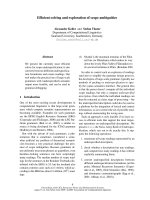Problem solving & decision making
Bạn đang xem bản rút gọn của tài liệu. Xem và tải ngay bản đầy đủ của tài liệu tại đây (514.79 KB, 39 trang )
MANAGEMENT SKILLS
Dr Thai Van Vinh
Part 4: Problem Solving & Decision
Making
1
Topics
• Decision making and problem solving
• The nature of decision making as part of
management
• Decision making approaches
• Factors in decision making
• Problem solving: making the most of
opportunities
• Thinking ‘outside the box’ and creativity
2
Learning Outcomes
• Upon completion of this module, you should be
module
able to comprehend:
– The nature of decision-making and problem solving as
part of management
– Important factors in decision making
– Various approaches to decision making and problem
solving
l i
3
Decision Making and Problem Solving
• Managers make many decisions – some small,
small
some large
• It can be generally argued that decision making
y
f
g
j
is the very essence of a manager’s job
• The ability to make good decisions is central to
the
th management of the organisation
t f th
i ti
• Solving p
g problems is purposeful and satisfying for
p p
y g
those of us who love business
Welcome them!
4
Decision Making and Problem Solving (C)
• Many authors and managers use the terms
decision making and problem solving
interchangeably and others treat decision making
i
h
bl
d h
d ii
ki
as a sub-category of problem solving
• Decision making is commonly defined as the act
of choosing from among alternatives while a
problem (or opportunity) is a situation offering
strong potential for significant gain if
t
t ti l f
i ifi t i
appropriate actions are taken
5
Decision Making and Problem Solving (C)
• In ancient times, a king had a boulder p
,
g
placed on a roadway.
y
Then he hid himself and watched to see if anyone would
remove the huge rock. Some of the kingdom’s wealthiest
merchants and courtiers came by and simply walked around it.
it
Many loudly blamed the King for not keeping the roads clear,
but none did anything about getting the big stone out of the
way.
way Then a peasant came along, carrying a load of vegetables.
along
vegetables
On approaching the boulder, he laid done his burden and tried
to move the stone to the side of the road. After much pushing
and straining he finall s cceeded He noticed a p rse
straining, finally succeeded.
purse…where
here
the boulder had been. The purse contained many gold coins
and a note from the King indicating that the gold was for the
person who removed the b ld from the roadway.
h
d h boulder f
h
d
• The peasant learned what many never understand: every
obstacle presents an opportunity to improve one’s condition.
6
Decision Making as Part of Management
• Decision making is important in every area of a
manager’s job
• Planning
– What are the organisation’s long-term objectives?
– What strategies will best achieve these objectives?
– What should the organisation’s short-term objectives
be?
– How difficult should individual goals be?
ff
g
?
7
Decision Making as Part of Management (C)
• Organising
– How many subordinates should I have report directly
to me?
– How much centralisation should there be in the
organisation?
– How should jobs be designed?
• Leading
– How do I handle employees who appear to be low in
motivation?
ti ti ?
– How will a specific change affect worker
productivity?
d ti it ?
8
Decision Making as Part of Management (C)
• Controlling
– What activities in the organisation need to be
controlled?
– How should these activities be controlled?
– When is a performance deviation significant?
– When should I discipline a problem employee?
9
Decision Making as Part of Management:
Programmed and Non Programmed Decisions
Non-Programmed
• Programmed decisions:
– made in routine, repetitive, well-structured situations
with predetermined decision rules
– may be based on habit, or established policies, rules
and procedures and stem from prior experience or
technical knowledge about what works or does not
work in a given situation
g
– are programmed to the extent that they are repetitive
and routine and that a definite approach has been
pp
worked out for handling them
– Ex: standardised routines for handling customer
g
complaints or employee discipline
10
Decision Making as Part of Management:
Programmed and Non Programmed Decisions
Non-Programmed
Non programmed
• Non-programmed decisions:
– are unique decisions that require a ‘custom made’
i
d ii
h
i
d
solution
– This is when a manager is confronted with an illstructured or novel problem and there is no ‘cut and
dried solution’
– Ex: the creation of a marketing strategy for a new
g
gy
service
11
Decision Making as Part of Management:
Certainty,
Certainty Risk and Uncertainty
• You make decisions now for action that will be
taken to achieve your goals in the future
• Important decision making situations often
contain some aspects that are unknowable and
very difficult to predict
– Decisions made at moments of uncertainty involve
risk and the possibilit that the course of action taken
possibility
co rse
can lead to losses rather than the desired results
– The uncertainty can come from a variety of sources
ncertaint
ariet
so rces
– Thus, SWOT, TOWS, and PESTLE analyses are
important
12
Decision Making as Part of Management:
Certainty,
Certainty Risk and Uncertainty (C)
The
world,
• ‘The best managers in the world a guy with a
Harvard MBA, might make bad decisions around
40% of the time And a rotten manager might
time.
make bad decisions 60% of the time’
– there’s only about a 20% difference
• But as a manager you have to make decisions
manager,
– If you don’t make decisions, you are going nowhere
and doing nothing
– If you make decisions, you will make bad decisions.
But
B you l
learn from it
f
i
13
Decision Making as Part of Management: Urgent
Versus Important Decisions
• A particularly useful time management technique
is to distinguish between urgent and important
decisions
• This distinction is significant as these two types
of decisions have to be dealt with differently
– urgent items have a deadline attached
– Important items also have a deadline. The deadline
for them is usually far enough in advance for there to
be sufficient time to focus primarily on quality
14
Decision Making Approaches: The Logical Systems
• Defining the problem
– Accurately defining the problem is essential
• Analysing the problem
– Analysing the problem necessitates an understanding
y g
p
g
of process
– If the process is clearly documented the cause of the
documented,
problem is more likely to emerge
• G
Generating alternative solutions
ti
lt
ti
l ti
– It is important to generate as many solutions to the
problem as possible within the parameters defined
15
Decision Making Approaches: The Logical Systems
(C)
g
• Choosing a solution or course of action
– evaluate against established criteria, the same criteria
applying to all possible solutions
– Th solution that most effectively meets the criteria
The l i
h
ff i l
h i i
should be selected
• Implementing the solution
– There is often a disparity between the solution agreed to
in a group and the solution implemented
g p
p
– To determine a plan for implementing the decision is
critical
• Evaluating the effectiveness of the solution
– Did the implementation plan meet the goals and
objectives?
bj ti ?
– Did the solution via the plan eliminate the problem? 16
Decision Making Approaches: Contingency
Approach
• This approach differentiate between
programmed and non-programmed decisions
• Rules and policies in programmed decisions
l
d li i i
dd i i
provide managers with a high degree of certainty
about the appropriateness of the solution
• In contrast, non-programmed decisions bring
contrast non programmed
managers a high degree of uncertainty and risk
• The risk may be reduced by a factor associated
with the increased number of people who
p p
participate in the problem solution
17
Decision Making Approaches: Decision Tree
• The Tree grows from left to right as a logical
sequence of events unfolds:
– E h chance is denoted by a circle; each decision by
Each h
i d
db
i l
hd i i b
a square
– Expected payoff for each decision is calculated by
combining probability & payoff of each alternative
• Steps involved:
– Drawing up the decision tree from left to right
– Estimating probability of occurrence
– Calculating the expected payoff, based on estimated
18
probability & payoff of each alternative
Decision Making Approaches: Decision Tree
19
Decision Making Approaches: Critical Path
Analysis
• Critical Path Analysis (CPA) or Critical Path
Method (CPM) is part of a planning system
called Network Analysis
Net ork Anal sis
• CPA uses the arrow diagram in which:
– A circle represents an event (or phase)
– The arrow points to the next event (or phase)
• Used to find out the shortest route
20
Decision Making Approaches: Program Evaluation
and Review Technique (PERT)
• It is similar to CPA and with the computerisation
PERT and CPA are often used interchangeably
• PERT also uses the arrow diagram but differs
l
h
di
b diff
when it estimates the duration of activities
• PERT requires th
i three estimates for every activity:
ti t f
ti it
– (i)
– (ii)
– (iii)
t (o) =
t (m) =
t (p) =
The most optimistic duration
The most likely duration
The most pessimistic duration
21
Decision Making Approaches: Program Evaluation
and Review Technique (PERT)
t (o) + 3t (m) + 2t(p)
t (e)
=
6
22
Decision Making Approaches: Group Quantitative
Approach
• The basis for quantitative approaches to decision
making is to harness the creative power of
groups
gro ps and use a variety of techniques to:
se ariet
techniq es
–
–
–
–
Generate broad parameters to the problems
Quickly collect a quantity of ideas on the issue
Collectively assess the alternatives; and
Agree on an strategy to create a solution
A
t t
t
t
l ti
23
Decision Making Approaches: Group Quantitative
Approach – The Delphi Technique
g p
• This works from a group basis whose members
never meet face to face
– First, the problem is identified and members are asked to
identify t ti l l ti
id tif potential solutions via questionnaire
i
ti
i
– The results of the questionnaire are collated centrally and
a copy sent to each member
– After reviewing the collated results of the questionnaire,
members are asked again by a second questionnaire for
their solutions and i
h i l i
d invariably the results of the first
i bl h
l f h fi
questionnaire trigger new solutions and change priorities
– The procedure is then repeated as often as necessary until
consensus is reached
• This technique is time consuming and relies on
q
g
quantitative analysis of the problem
24
Decision Making Approaches: The Qualitative
Approach – The PDCA Cycle
25









